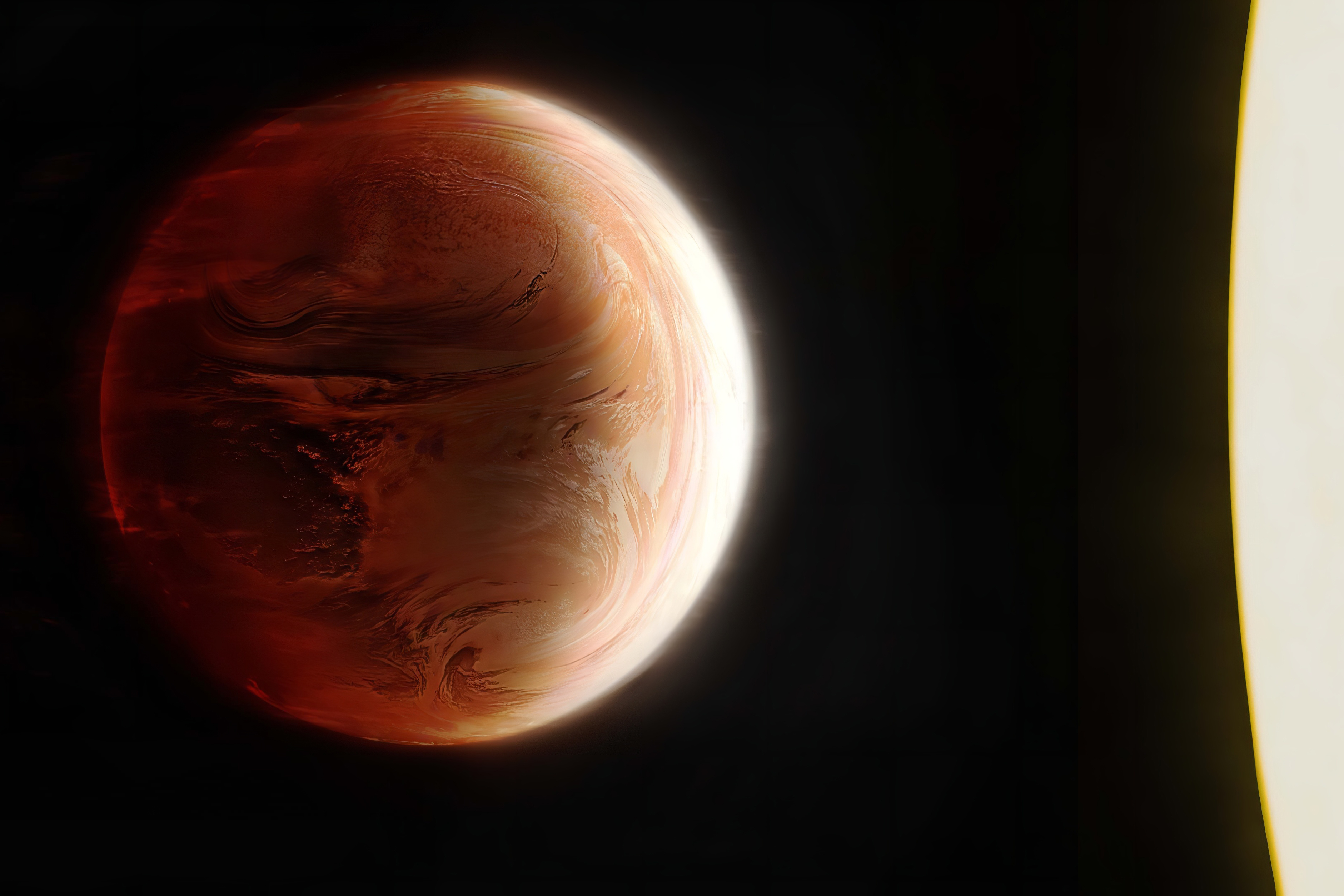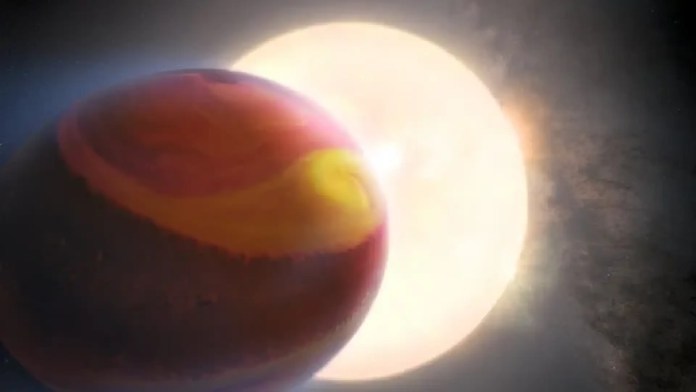Venus is the hottest planet in the Solar System. Its average surface temperature exceeds 470°C (880°F).
Despite being second in line from the Sun, Venus surpasses Mercury’s heat due to its thick, toxic atmosphere, composed primarily of carbon dioxide with clouds of sulfuric acid. This atmosphere traps heat through a runaway greenhouse effect, making Venus an extreme example of climate processes.
The fascination with this infernal environment makes Venus a subject of intense study, as it contrasts starkly with the hospitable conditions on Earth. Understanding Venus’s climate and atmosphere offers insights into planetary formation, weather patterns, and potential climate change scenarios. Its proximity to Earth and extreme conditions provide a natural laboratory for scientists exploring the boundaries of planetary science. Venus, shrouded in mystery and blistering heat, remains an enigma and a warning of the powers of atmospheric effects.

Credit: www.nasa.gov
Misconceptions About The Hottest Planet
Think of a planet closer to the sun, and you might guess it’s the hottest. But that’s not true! Our solar system has a surprise for you. This part of the blog will unearth common myths about the hottest planet. Let’s dive in and turn up the heat on these misconceptions.
Closer To The Sun, Hotter The Planet?
Does closer mean hotter? Not really. Mercury is closest to the sun, but it’s not the hottest. It lacks a thick atmosphere, so it can’t trap heat. The real scorcher in our solar system is Venus. Its thick clouds act like a blanket, keeping it sizzling hot!
| Mercury | Venus |
|---|---|
| Close to the Sun | Second Closest |
| No thick atmosphere | Thick atmosphere |
| Can’t hold heat well | Traps heat efficiently |
Popular Beliefs Vs. Scientific Facts
Popular beliefs often get it wrong. Science tells a different story. Venus, not Mercury, is the hotshot of our Solar System. Let’s look at some facts:
- Venus surface temp: around 465°C
- Mercury surface temp: up to 430°C
Despite being second in line to the sun, Venus rules with the highest temperatures, all thanks to its atmosphere full of carbon dioxide. This explains why distance from the sun isn’t everything. Planetary atmospheres play a huge role.

Credit: news.mit.edu
Revealing The Hottest Planet
In our solar family, there’s a burning question to be answered. Which planet holds the title for the hottest? The answer might surprise you. It’s not the one closest to the sun. With temperatures soaring high enough to melt lead, the hottest planet will leave you in awe. Let’s unravel this fiery mystery, planet by planet.
Mercury Proximity to the SunMercury’s Proximity To The Sun
Many assume that Mercury, as the closest planet to the sun, must be the steamiest. It’s a reasonable guess, considering its snug orbit. But the truth is a bit cooler. Notable facts:
- Mercury has no atmosphere to trap heat.
- Daytime temperatures can reach 430°C.
- Nighttime can plummet to -180°C.
Mercury’s temperature swings are the most extreme. However, these aren’t hot enough to take the top spot. The hottest planet hides behind a veil, shrouded in thick clouds.
Venus Fiery World under the CloudsVenus: A Fiery World Under The Clouds
Step aside, Mercury, for Venus is our solar system’s true scorching star. Look past the swirling clouds and you’ll discover a world of extremes:
| Atmosphere Composition | Surface Temperature | Pressure |
|---|---|---|
| Carbon Dioxide (96.5%) and Nitrogen (3.5%) | Average around 467°C | 90 times Earth’s |
Why is Venus hotter than Mercury? Its atmosphere is the key. Thick with carbon dioxide, it gets trapped in a runaway greenhouse effect, keeping heat circulating. Boldly, Venus reigns as the hottest planet in our solar system.
Factors Contributing To Extreme Heat
When we ponder the fiery furnaces of our solar system, one planet burns brighter than the rest. It’s not Mercury, the closest planet to the Sun, but Venus that holds the title of the hottest planet. Several factors explain Venus’s scorching climates, from its cloak-like atmosphere to a runway of greenhouse effects.
Venusian Atmosphere: A Thick, Heat-trapping Blanket
Venus wields an atmosphere unlike any other planet in our cosmic neighborhood. This dense shroud is rich in carbon dioxide and is nearly 90 times more massive than Earth’s, acting like a thick blanket.
Imagine wearing a heavy coat on a sunny day. The Sun’s warmth is trapped, and you start to feel hotter. Venus’s atmosphere does the same on a planetary scale, trapping heat effectively.
Greenhouse Gases And Runaway Effects
and Venus’s air is full of them. Carbon dioxide and water vapor, the two heavyweight champions of greenhouse gases, lock in heat from the Sun’s rays. Venus has them in abundance, and the planet’s surface temperature soars as a result. This spiraling temperature increase is known as the runaway greenhouse effect. Simply put, it’s like leaving the heater on full blast in a sealed room.
- Heat from the sunlight gets in but can’t get out.
- More heat means more energy, thus even more trapped heat.
- The cycle continues, and Venus gets hotter and hotter.
This extraordinary effect makes Venus’s surface hotter than a typical pizza oven. With temperatures high enough to melt lead, Venus stands as a reminder of the power of atmospheres and the greenhouse effect.

Credit: exoplanets.nasa.gov
Exploring The Surface And Climate Of Venus
Venus stands out as the hottest planet in our Solar System. Despite its beauty in the night sky, the surface and climate reveal a hostile world. Below we’ll uncover why Venus, not Mercury, is the scorching champion.
Severe Weather Patterns
Venus features extreme weather unlike anywhere else. Fast-moving clouds wrap around the planet, trapping heat and creating a runaway greenhouse effect. With a thick atmosphere mostly composed of carbon dioxide, the weather patterns produce immense pressure and heat. Here’s how Venus’s climate compares:
- Winds: Highlands enjoy calmer airs, while the lowlands face fierce ones.
- Pressure: It is like being 900 meters underwater on Earth.
- Heat: Hot enough to melt lead, with average temperatures soaring.
Volcanic Activities And Surface Temperature
Venus is home to thousands of volcanoes. These range from small volcanic constructs to vast lava plains, showing the planet is geologically active. The surface temperature from this volcanic activity reaches astonishing highs. Important data presented in tabular form helps paint this hot picture:
| Feature | Measurement |
|---|---|
| Surface Temperature | Around 900°F (475°C), even at night |
| Lava Flows | Covering 85% of Venus’s surface |
| Active Volcanoes | Potentially hundreds still active today |
The heat from the ongoing volcanic activity contributes significantly to the unyielding temperature on Venus, making it the hottest planet.
Implications For Space Exploration
The quest to unravel the mysteries of our solar system has led to extraordinary discoveries. As we reach for the stars, one planet presents a daunting challenge while promising scientific bounty: Venus, the hottest planet in the solar system. Let’s explore the implications for space exploration.
Challenges In Landing On Venus
Venus’s extreme conditions pose major hurdles for spacecraft. With surface temperatures hot enough to melt lead and atmospheric pressure crushing at 92 times that of Earth’s, landing and surviving on Venus is a formidable task.
- Hostile temperatures: over 860 degrees Fahrenheit.
- Crushing pressure: akin to being 3,000 feet underwater.
- Corrosive atmosphere: thick with clouds of sulfuric acid.
- Electronic failure risk: due to intense heat and pressure.
Landing a probe requires materials and systems that can withstand these harsh conditions for more than just a few hours.
Future Missions And Research Opportunities
Despite the risks, Venus’s allure beckons. Future missions focus on technology breakthroughs and scientific inquiries.
| Mission | Objective | Expected Launch |
|---|---|---|
| VERITAS (NASA) | Map Venus’s surface in high detail. | 2028 |
| DAVINCI+ (NASA) | Study the atmosphere and determine if Venus ever had an ocean. | 2030 |
| EnVision (ESA) | Probe geological activity and history. | 2030s |
These missions promise to unpick Venus’s secrets and may pave the way for advanced robotic exploration or even manned missions.
Life Beyond Earth: Lessons From Venus
Life Beyond Earth: Lessons from Venus stirs curiosity about our cosmic neighbors. Often we gaze upon the stars, pondering the existence of life elsewhere. Venus, the hottest planet in the solar system, provides an unexpected classroom. This scorching world embarks us on a journey of discovery, especially in understanding Earth and in the search for life in harsh environments.
Understanding Earth’s Climate Through Venus
Comparing Venus to Earth reveals stark climate contrasts. The dense atmosphere of Venus, rich in carbon dioxide, creates a runaway greenhouse effect. This traps heat, soaring temperatures to the highest in our solar system. Learning from Venus, scientists unravel climate mysteries here on Earth. By studying Venus’ extreme conditions, we gain insights into our own planet’s climate system.
Search For Habitability In Extreme Conditions
Extreme environments like those on Venus help scientists explore limits of life. If microorganisms can survive Venus’ harsh conditions, then other cosmic bodies could host life. The search focuses on resilient life forms, potentially hiding in Venus’ cloud decks. Venus teaches us to look for life in places we never thought possible. Through this search, we broaden our understanding of where life might exist beyond Earth.
Frequently Asked Questions On What Is The Hottest Planet In The Solar System
Which Is Hotter Venus Or Mercury?
Venus is hotter than Mercury, despite being farther from the Sun, due to its thick, heat-trapping atmosphere.
Is Pluto Hotter Than Venus?
No, Venus is hotter than Pluto. Venus, with its thick atmosphere, has an average temperature of about 465°C, while Pluto’s temperature can drop to -229°C.
What Planet Is The Coldest?
The coldest planet in our solar system is Neptune. Its average temperature plummets to about minus 214 degrees Celsius. Neptune’s great distance from the Sun contributes to its extreme cold.
What Is The Hottest Planet To Ever Exist?
The hottest known planet is KELT-9b, with temperatures reaching approximately 4,300 degrees Celsius. This exoplanet outshines others in scorching heat due to its close orbit around a highly luminous host star.
Conclusion
As we’ve journeyed through the scorching realms of our solar system, Venus stands out as the ultimate champion of heat. Its crushing atmosphere and greenhouse gas embrace make it a planetary furnace, unmatched by any other. So, whether stargazing or delving into astronomical facts, remember Venus, a world where each day sizzles beyond imagination.
Keep exploring, and stay curious about the fascinating dynamics that govern our celestial neighbors.





